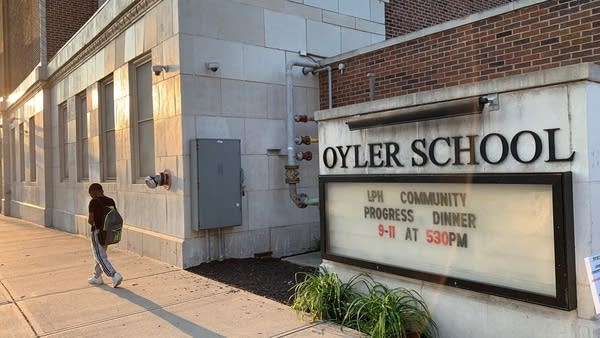Bridging the edtech gap from Oyler School to home
Students without devices or broadband access at home can fall behind.

Ray Nephew’s seventh-grade English class at Oyler School is about as high-tech as it gets. Every student has a laptop to use. On one wall, a device turns his whiteboard into an interactive touch screen. A 32-inch “coffee table” computer sits idle against another wall, covered with a cloth.
“That thing is malfunctioning,” Nephew says.
Nephew explains that it is a great tool — when the computer works.
“It’s just another way for kids to be engaged,” he says.
This is not your typical classroom at Oyler School, a high-poverty school in Cincinnati, Ohio, or in most places. It’s one of six “demonstration classrooms” in the district. Teachers from around the city visit to watch Nephew model the latest teaching techniques and technology.
On this day, students work on their laptops, preparing presentations about a novel they’ve just read. Student Edward Denham, sporting glasses and a mop of wavy brown hair, selects a font to use for his digital slideshow.
“I always choose neon green, because it’s awesome,” he says.
Ed is 12, and he loves computers. But when he goes home at the end of the day, he has to leave the laptop at school. In his small beige house a block from Oyler, Ed has an Xbox game console, but no computer anymore. His mom, Diane Gribbins, had a laptop years ago when she had a job at a bank.
“Like everything else, they wear out or tear up,” she says. “I just don’t have the cash to replace something like that when it goes.”
The family of six can’t afford high-speed internet either. Like many kids at Oyler, Ed has a smart phone, but he says the connection is slow.
“If I had internet at home, the first thing I’m asking my mom for is a laptop,” he says. “You can use a laptop for so many things that I can’t do on my phone.”
Like watch videos on YouTube, he says, and play better games.
“A lot of research and things you could be looking up for school, too,” his mom interjects. “You could do that.”
Oh yeah, school work. It’s not exactly easy to write a paper on a smart phone. Games aren’t just play for Edward, though. He wants to be a game designer.
There’s a name for Ed’s situation, says Jim Steyer, CEO of the advocacy group Common Sense Media. He calls it “the homework gap.” As schools bring high-speed internet and the latest devices into the classroom, he says nearly one-third of families still lack broadband access at home.
“We see this situation in low-income schools across the country, where kids do not have access to the internet at home and literally can’t do homework assignments that their technology-enabled classrooms would require,” Steyer says.
Oyler is working to close that gap. The school has teamed up with a local telecom company to bring several free WiFi hotspots to the neighborhood. None of them reaches Ed’s house yet. Even kids who now have access don’t always have the right device, Nephew says.
“It’s forced us to do more in class than we really want to eventually have to do,” he says. “We try to move towards that flipped classroom model, where the students can do a lot of the work outside of class via Blackboard or their Google account, but if you don’t have a device at home, and all you have is a smart phone, it is more difficult.”
Technology has flipped the classroom in another way. Nephew is 52, and before this year had never even had a computer in his classroom.
“My 15-year-old daughter would make fun of me that I couldn’t send a text message or know how to work the new TV remote,” he says.
Nephew often asks his students for help, and that’s been empowering for kids like Ed. At a recent tech fair, he and his classmates got to dress up in professional clothes and school the teachers on using their computers.
“It felt like they were actually learning something about it, and I was actually teaching them about it,” Ed says. “I was being helpful to them.”
Nephew still has plenty to teach Ed and his fellow digital natives. In his high-tech classroom, Nephew discovered a far more basic gap. Before the book they just finished reading, he says, most of his seventh graders had never read a novel.







